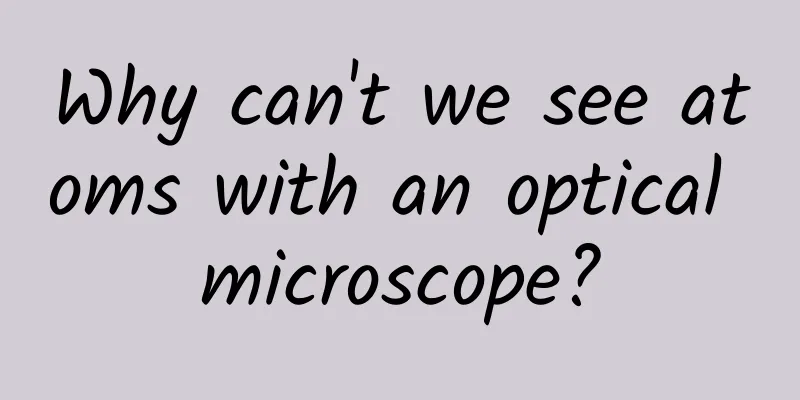Why can't we see atoms with an optical microscope?

|
Through an optical microscope, we can see bacteria and cells that are invisible to the naked eye, but we are powerless when it comes to smaller things, such as atoms. Why can't an optical microscope see atoms? You may naturally think that it is because the optical microscope is not powerful enough, but the real reason is not like this, or this statement is not accurate enough. Before the 17th century, humans knew nothing about the microscopic world until the advent of the microscope. However, the magnification of the earliest microscopes was extremely limited. It was impossible to use it to observe microorganisms. At most, it could be used to observe fleas. Despite this, microscopes were still rare and expensive items at the time. A janitor named "Leeven Hooke" was also very interested in microscopes, but he did not have the money to buy such an expensive item, so he chose to grind the microscope himself. It has to be said that Robert Hooke's technique for grinding mirrors was absolutely outstanding. He ground a lens into a tiny glass bead and inlaid it in a small hole in a copper sheet, thus making a microscope with a simple structure. Although Leeuwen Hooke's microscope was simple in structure, it was powerful and could magnify objects 300 times. In fact, what he ground was a real microscope. Later, Leeuwen Hooke discovered the existence of bacteria and red blood cells in the blood with the microscope he ground. Because of Leeuwen Hooke's amazing discovery, he became the first member of the Royal Society in history who did not know Latin. Before that, Latin was a basic requirement for becoming a member because Latin was the universal language of science. It has been nearly 400 years since Robert Hooke invented the true microscope. The magnification capability of modern optical microscopes is far beyond what it used to be, and can magnify the image of an object up to 2,000 times. So through an optical microscope, we can now clearly see the cells of animals or plants, but if we want to explore a more microscopic world, an optical microscope is powerless. What is smaller than a cell? It is an atom. How small is an atom? A drop of water that we usually talk about is about 0.05 ml, and this drop of water contains at least 10 trillion water molecules, and each water molecule is composed of 2 hydrogen atoms and 1 oxygen atom. It can be seen how small an atom is. For example, copper, the number of copper atoms contained in 1 gram of copper reaches 95 trillion trillion. Atoms are indeed much smaller than bacteria and cells, and cannot be seen using existing optical microscopes. So, wouldn't it be enough to just continue to increase the magnification of the optical microscope? No, the reason why this is not possible is determined by the inherent principles of the optical microscope. Optical microscopes rely on visible light to observe objects. What is visible light? It is light with a wavelength between 390 nanometers and 780 nanometers. The diameter of an atom is on the order of 10 to the -10th power of meters. Obviously, the diameter of an atom is much smaller than the wavelength of light. This shows that this is not a problem of magnification, because visible light with a wavelength much larger than the atomic diameter will undergo obvious diffraction when it encounters an atom, resulting in an inability to form a clear image. Since we cannot observe atoms through visible light, how do we know the atomic structure? Although the wavelength of visible light is much larger than the diameter of an atom, there are many other things in the world whose wavelengths are much smaller than atoms, such as electrons. The wavelength of electrons is on the order of 10 to the -12th power of meters, so it is entirely possible to use electrons to observe atoms. So in 1933, the world's first electron microscope came out. Electron microscopes are completely different from traditional optical microscopes. When working, they emit high-energy electron beams to the target. These electron beams interact with the target after contact. Then the electron microscope draws images based on the effects of these interactions. Then we can observe atoms through the images presented by the electron microscope. However, electron microscopes can only observe atoms in sheets. It is still impossible to make subtle observations of individual atoms, so the "scanning tunneling microscope" was born. The core principle of scanning tunneling microscopy is the quantum tunneling effect. When working, it will use a needle-like probe the size of an atom to approach the observation target and add voltage between the probe and the observation target. As the distance between the two is shortened, a tunnel current will be generated due to the quantum tunneling effect. When the probe scans different parts of the observation target, the generated tunnel current will fluctuate. The scanning tunneling microscope will record this fluctuation and draw it into an image. Through the image, we can intuitively see what the atom looks like. So how small can the scanning tunneling microscope see? Its resolution can reach 0.01 nanometers. It is precisely because of such a powerful tool that we are fortunate enough to see microscopic structures that are impossible to see with the naked eye. For more information, please follow the official account: sunmonarch |
>>: Can prolonged use of mobile phones cause cerebral infarction? These habits are no joke!
Recommend
What has happened on Earth in the past 4.6 billion years?
Speaking of the history of the Earth, it may be c...
What do ROI, CPA, CPC, and OCPM mean in SEM promotion?
In every industry, there are unique professional ...
Marketing promotion: 6 ways to make your ads more memorable
There are thousands of ideas popping up in this w...
What are the strategies and models behind Qutoutiao’s crazy growth?
Qutoutiao launched its product in June 2016, and ...
Can WeChat on PC open mini programs? How to use WeChat mini programs on a computer?
Can WeChat on PC open mini-programs? How to use W...
How to use the WeChat restaurant ordering app? Do these things to double your store's performance!
Since Zhang Xiaolong launched WeChat Mini Program...
Microplastics that may threaten health are already in the air we breathe
Microplastics, as the name suggests, refer to ext...
Help! How come some fish have teeth like humans? | Nature Trumpet
Welcome to the 39th issue of the Nature Trumpet c...
Editing, algorithms and social media, content distribution divided into three parts?
Let me first put forward my personal conclusion: ...
How far can Luo Yonghao’s “Bullet Messenger” fly?
[[241148]] one The Luo family crosstalk performan...
How can humans have high-quality sleep?
One third of a person's life is spent sleepin...
Some pretend to be shit, some pretend to be dead, you frogs are really cunning! | Nature Trumpet
Welcome to the 45th issue of the Nature Trumpet c...
In addition to iOS 9, there are many more Apple WWDC 2015 previews
Apple's 2015 Worldwide Developers Conference ...
How to escape from a fire? No equipment is needed!
As the saying goes, "fire and water are merc...









![Video account sales tutorial: Teach you how to make health tea step by step, and easily earn 100,000+ yuan a month [Video course]](/upload/images/67cc3051d7fd9.webp)